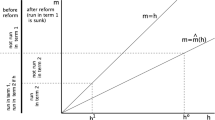Conclusion
The theory of reform predicts that reform municipal institutions should be less indulgent of special interests than are traditional institutions. However, reform city councils have unambiguously positive effects on city employment levels and compensation for municipal employees. These effects are inconsistent with reform predictions.
These effects are consistent with the logic of constituency-building. City council elections held under reform rules reduce the electoral effectivenes of traditional party and neighborhood constituencies. Successful candidates must therefore appeal to others. Municipal employees are one available alternative. The results above indicate that they are relatively more powerful under reform than under traditional council elections. They use this power to obtain measurable returns through the municipal labor market.
Similar content being viewed by others
References
Advisory Commission on Intergovernmental Relations. (1981). Measuring local discretionary authority. Washington, DC.
Advisory Commission on Intergovernmental Relations. (1978). State mandating of local expenditures. Washington, DC.
Baker, D.G. and Colby, D.C. (1981). The politics of municipal employment policy: A comparative study of U.S. cities. American Journal of Economics and Sociology 40 (3): 249–263.
Beard, C.A. (1917). Political parties in city government: A reconsideration of old viewpoints. National Municipal Review 6 (2): 201–206.
Bennett, J.T. and Orzechowski, W.P. (1983). The voting behavior of bureaucrats: Some empirical evidence. Public Choice 41 (2): 271–283.
Bryant, S. (1976). The dimensions of reformism in urban policy analysis. Urban Affairs Quarterly 12 (1): 117–124.
Clark, T.N. (1970). Urban typologies and political outputs: Causal models using discrete variables and orthogonal factors, or precise distortion versus model muddling. Social Science Information 9 (6): 7–33.
Cole, R.L. (1971). The urban policy process: A note on structural and regional influences. Social Science Quarterly 52 (3): 646–655.
Courant, P.M., Gramlich, E.M. and Rubinfeld, D.L. (1979). Public employee market power and the level of government spending. American Economic Review 69 (5): 806–817.
Cox, G.W. (1984). Strategic electoral choice in multi-member districts: Approval voting in practice? American Journal of Political Science 28 (4): 722–738.
Davidson, C. and Korbel, G. (1981). At-large elections and minority-group representation: A reexamination of historical and contemporary evidence. The Journal of Politics 43 (4): 982–1005.
Edwards, L.N. and Edwards, F.R. (1982). Public unions, local government structure and the compensation of municipal sanitation workers. Economic Inquiry 20 (3): 405–425.
Ehrenberg, R.G. (1973). Municipal government structure, unionization, and the wages of fire fighters. Industrial and Labor Relations Review 27 (1): 36–48.
Ehrenberg, R.G. and Goldstein, G. (1975). A model of public sector wage determination. Journal of Urban Economics 2 (3): 222–245.
Freeman, R.B. and Valleta, R.G. (1988). The effects of public sector labor laws on labor market institutions and outcomes. In R.B. Freeman and C. Ichniowski (Eds.), When public sector workers unionize, 81–103. Chicago: The University of Chicago Press.
Friend, E.H. and Bencivenga, D.F. (1979). Fourth national survey of employee benefits for full-time personnel of U.S. municipalities. Washington, DC: Labor-Management Relations Service of the United States Conference of Mayors.
Friend, E.H. and Lufkin, L.A. (1982). Fifth national survey of employee benefits for full-time personnel of U.S. municipalities. Washington, DC: Labor-Management Relations Service of the United States Conference of Mayors.
Friend, E.H. and Pike, A. (1977). Third national survey of employee benefits for full-time personnel of U.S. municipalities. Washington, DC: Labor-Management Relations Service of the United States Conference of Mayors.
Gramlich, E.M. and Rubinfeld, D.L. (1982). Voting on public spending: Differences between public employees, transfer recipients, and private workers. Journal of Policy Analysis and Management 1 (4): 516–533.
Hill, M.B. (1978). State laws governing local government structure and administration. Athens, GA: Institute of Government, University of Georgia.
Ichniowski, C. (1980). Economic effects of the firefighter's union. Industrial and Labor Relations Review 33 (2): 198–211.
Ladd, H.F. and Wilson, J.B. (1983). Who supports tax limitations: Evidence from Massachusetts' proposition 2 1/2. Journal of Policy Analysis and Management 2 (2): 256–279.
Lineberry, R.L. and Fowler, E.P. (1967). Reformism and public policies in American cities. American Political Science Review 41 (3): 701–716.
Lyons, W. (1978). Reform and response in American cities: Structure and policy reconsidered. Social Science Quarterly 59 (1): 118–132.
Maser, S.M. (1985). Demographic factors affecting constitutional decisions: The case of municipal charters. Public Choice 47 (1): 121–162.
Miller, G.J. (1985). Progressive reform as induced institutional preferences. Public Choice 47 (1): 163–181.
Morgan, D.R. and Pelissero, J.P. (1984). Urban policy: Does political structure matter? The American Political Science Review 74 (4): 999–1005.
Pindyck, R.S. and Rubinfeld, D.L. (1981). Econometric models and economic forecasts. New York: McGraw-Hill.
Sanders, H.T. (1983). The government of American cities: Continuity and change in structure. In The municipal yearbook 1982. Washington, DC: International City Management Association.
Tucker, S. (1982). The organizational dynamics of service provision in a machine and a reform county agency. Human Relations 35 (11): 1015–1042.
U.S. Bureau of the Census. (1975, 1976, 1978). Annual survey of governments. Washington, DC.
U.S. Bureau of the Census. (1970, 1980). Census of population and housing. Washington, DC.
Zax, J.S. (1988). Labor relations, wages and nonwage compensation in municipal employment. Industrial Relations 27 (3): 301–317.
Author information
Authors and Affiliations
Additional information
The Social Science Research Council, through grant SS-25-83-04, and the Project in State and Local Government Finance of the National Bureau of Economic Research supported the research presented in this paper. Roo Canfield assisted, indispensably, with the empirical analysis. Linda Edwards, Jim Hines, Jonathan Leonard, Robert Lipsey and Donald Walls have been generous with constructive comments. Only I am responsible for the content.
Rights and permissions
About this article
Cite this article
Zax, J.S. Reform city councils and municipal employees. Public Choice 64, 167–177 (1990). https://doi.org/10.1007/BF00153162
Issue Date:
DOI: https://doi.org/10.1007/BF00153162




